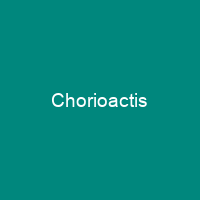Chorioactis: The Mysterious Fungus That Looks Like a Devil’s Cigar

Imagine a mushroom that looks like a bloated cigar, splitting open into starlike rays. Sounds like something out of a fairy tale, right? That’s the rare and fascinating Chorioactis geaster, also known as the Devil’s Cigar.
The Enigma of Chorioactis
First discovered in 1893, this unique fungus has been shrouded in mystery. It grows on dead cedar elms or oaks and is found in select locales in Texas and Japan. Its unusual appearance makes it a subject of wonder and curiosity among mycologists and nature enthusiasts alike.
Phylogenetic Puzzles
The classification of Chorioactis has been a puzzle for scientists. Initially placed in the family Sarcosomataceae, phylogenetic analyses have revealed that it belongs to its own distinct genus within the family Chorioactidaceae. This discovery adds another layer of intrigue to this already mysterious fungus.
The Devil’s Cigar: A Name Fit for a Fungus
According to American mycologist Fred Jay Seaver, the name ‘Devil’s Cigar’ could refer to either its young specimens resembling a bloated cigar or the fact that it appears to ‘smoke’ at maturity. But which is true? Is this just a clever play on words or does it hold some deeper truth?
A State Fungus of Texas
In 1997, Texas State Senator Chris Harris proposed making Chorioactis geaster the official state fungus of Texas. The bill passed the Senate but failed in the House. However, in 2021, the Texas Legislature finally designated it as the ‘State Mushroom of Texas.’ This recognition underscores the cultural and ecological significance of this unique fungus.
Japanese Traditions
In Japan, Chorioactis geaster is known as kirinomitake. The immature fruit body bears a resemblance to the seed pods of kiri, the empress tree. This name adds another layer of cultural richness to the already fascinating history of this fungus.
Life Cycle and Characteristics
The young specimens of Chorioactis geaster have a hollow, club-shaped, dark-brown fruit body connected to a stem that is usually buried in the ground. The stem has white flesh with a yellowish-white inner surface that turns light brown with age. As it matures, the fruit body splits open into four to seven rays that curve downward, similar to mushrooms of the genus Geastrum.
The spores are oblong to spindle-shaped and develop simultaneously within the ascus. The fruit body consists of three layers: hymenium, hypothecium, and excipulum. The paraphyses swell with age, causing the expansion of the hymenium and splitting of the fruit body into rays.
Geographical Variations
The natural habitat of Chorioactis geaster in Japan is disappearing due to deforestation and replanting with Japanese cedar. In Texas, it grows from roots of dead trees, particularly cedar elm or Symplocos myrtacea. The population in Japan has been separated from the one in Texas for at least 19 million years, ruling out human introduction.
The preferred host of Texan populations is typically roots and stumps of Ulmus crassifolia, while Japanese populations grow on the fallen trunks of Symplocos myrtacea and Quercus gilva. Texan species thrive in areas subjected to periodic flooding, whereas their Japanese counterparts do not.
Conclusion
The Chorioactis geaster is a fascinating fungus that continues to captivate scientists and nature lovers with its unique appearance and mysterious history. From the Devil’s Cigar moniker to its official status as Texas’s state mushroom, this rare species holds many secrets waiting to be uncovered. As we continue to explore and understand these natural wonders, perhaps we can unravel more of their enigmatic tales.
You want to know more about Chorioactis?
This page is based on the article Chorioactis published in Wikipedia (retrieved on November 25, 2024) and was automatically summarized using artificial intelligence.







